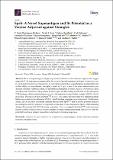Files in this item
SpeS : a novel superantigen and its potential as a vaccine adjuvant against strangles
Item metadata
| dc.contributor.author | Dominguez-Medina, C. Coral | |
| dc.contributor.author | Rash, Nicola L. | |
| dc.contributor.author | Robillard, Sylvain | |
| dc.contributor.author | Robinson, Carl | |
| dc.contributor.author | Efstratiou, Androulla | |
| dc.contributor.author | Broughton, Karen | |
| dc.contributor.author | Parkhill, Julian | |
| dc.contributor.author | Holden, Matthew | |
| dc.contributor.author | Lopez-Alvarez, Maria R. | |
| dc.contributor.author | Paillot, Romain | |
| dc.contributor.author | Waller, Andrew S. | |
| dc.date.accessioned | 2020-07-13T16:30:02Z | |
| dc.date.available | 2020-07-13T16:30:02Z | |
| dc.date.issued | 2020-06-23 | |
| dc.identifier | 268575426 | |
| dc.identifier | 04ab05bc-aba4-447a-9593-e7aad6619c97 | |
| dc.identifier | 85086919916 | |
| dc.identifier | 000549438600001 | |
| dc.identifier.citation | Dominguez-Medina , C C , Rash , N L , Robillard , S , Robinson , C , Efstratiou , A , Broughton , K , Parkhill , J , Holden , M , Lopez-Alvarez , M R , Paillot , R & Waller , A S 2020 , ' SpeS : a novel superantigen and its potential as a vaccine adjuvant against strangles ' , International Journal of Molecular Sciences , vol. 21 , no. 12 , 4467 . https://doi.org/10.3390/ijms21124467 | en |
| dc.identifier.issn | 1422-0067 | |
| dc.identifier.other | ORCID: /0000-0002-4958-2166/work/77524805 | |
| dc.identifier.uri | https://hdl.handle.net/10023/20240 | |
| dc.description | Funding: This research was funded by the Biotechnology and Biological Sciences Research Council (BBSRC) (BB/P002757/1). | en |
| dc.description.abstract | Bacterial superantigens (sAgs) are powerful activators of the immune response that trigger unspecific T cell responses accompanied by the release of pro-inflammatory cytokines. Streptococcus equi (S. equi) and Streptococcus zooepidemicus (S. zooepidemicus) produce sAgs that play an important role in their ability to cause disease. Strangles, caused by S. equi, is one of the most common infectious diseases of horses worldwide. Here, we report the identification of a new sAg of S. zooepidemicus, SpeS, and show that mutation of the putative T cell receptor (TCR)-binding motif (YAY to IAY) abrogated TCR-binding, whilst maintaining interaction with major histocompatibility complex (MHC) class II molecules. The fusion of SpeS and SpeSY39I to six S. equi surface proteins using two different peptide linkers was conducted to determine if MHC class II-binding properties were maintained. Proliferation assays, qPCR and flow cytometry analysis showed that SpeSY39I and its fusion proteins induced less mitogenic activity and interferon gamma expression when compared to SpeS, whilst retaining APC-binding properties. Our data suggest that SpeSY39I-surface protein fusions could be used to direct vaccine antigens towards antigen presenting cells in vivo with the potential to enhance antigen presentation and improve immune responses. | |
| dc.format.extent | 15 | |
| dc.format.extent | 2958438 | |
| dc.language.iso | eng | |
| dc.relation.ispartof | International Journal of Molecular Sciences | en |
| dc.subject | Streptococcus equi | en |
| dc.subject | Streptococcus zooepedemicus | en |
| dc.subject | Superantigen | en |
| dc.subject | Vaccine | en |
| dc.subject | Adjuvant | en |
| dc.subject | Immune response | en |
| dc.subject | Strangles | en |
| dc.subject | Horse | en |
| dc.subject | QH301 Biology | en |
| dc.subject | QR180 Immunology | en |
| dc.subject | DAS | en |
| dc.subject | SDG 3 - Good Health and Well-being | en |
| dc.subject.lcc | QH301 | en |
| dc.subject.lcc | QR180 | en |
| dc.title | SpeS : a novel superantigen and its potential as a vaccine adjuvant against strangles | en |
| dc.type | Journal article | en |
| dc.contributor.institution | University of St Andrews. Infection and Global Health Division | en |
| dc.contributor.institution | University of St Andrews. Biomedical Sciences Research Complex | en |
| dc.contributor.institution | University of St Andrews. Infection Group | en |
| dc.contributor.institution | University of St Andrews. School of Medicine | en |
| dc.identifier.doi | 10.3390/ijms21124467 | |
| dc.description.status | Peer reviewed | en |
This item appears in the following Collection(s)
Items in the St Andrews Research Repository are protected by copyright, with all rights reserved, unless otherwise indicated.

